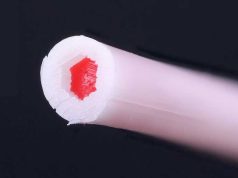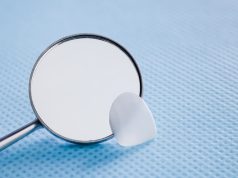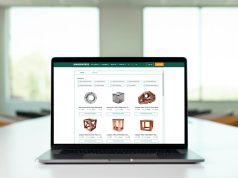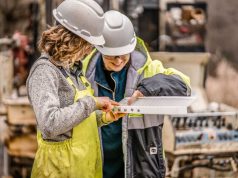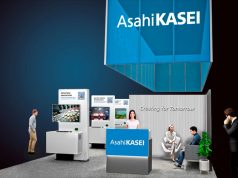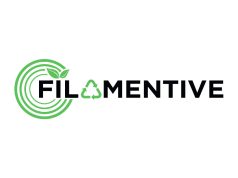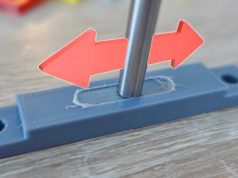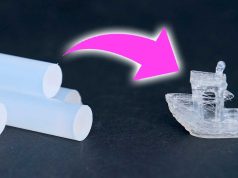Cooperation of UpNano and BIO INX yields further advancement: Two-stage 3D-printing of organ-on-chip devices with encapsulated live cells is possible.
The launch of a new biocompatible hydrogel resin marks the begin of a new era in bioprinting. The novel resin allows 2-photon polymerization (2PP) 3D-printing from micro- to meso-scale at highest resolution. The reactivity and easy processing of the material permits the fabrication of complex and versatile organ- or lab-on-chip designs. This new bioink called Hydrotech INX U200 has been developed by the material specialist BIO INX (Belgium) in collaboration with UpNano (Austria), leading manufacturer of 2PP 3D-printers. The results of this collaboration now allow to add an additional layer of complexity to a bioprinted construct by the smart combination of multiple biocompatible materials. In this respect versatile cancer-on-chip models are possible by combining the newly launched resin with cell-encapsulating gelatin-based hydrogel Hydrobio INX U200, which is the first commercially available high resolution bio ink that offers cell interactivity.
The ever-increasing possibilities of bioprinting are nurtured by a continuous advancement of 3D-bioprinting technologies. In this, 2-photon polymerization (2PP) 3D-printing excels as it covers the entire spectrum of biological dimensions with one printing technology: sub-micrometer resolution combined with the capability of printing objects at centimeter dimensions (macro-scale). This impressive potential has now been advanced by a set of bioinks jointly developed by BIO INX, 3D-bioprinting material specialist, and UpNano, leading manufacturer of 2PP 3D-printers.
Macrostructures with Micrometer-Precision
With the release of Hydrotech INX U200 the two companies demonstrate their success in developing a versatile material that enables 2PP 3D-printing of macrostructures with micrometer-precision. The material has been certified according to ISO 10993-5, confirming its excellent biocompatibility. Jasper Van Hoorick, CEO of BIO INX, comments: “In combination with the fact that the material is completely bio-inert, its robust characteristics make Hydrotech INX U200 the ideal choice for organ-on-chip applications.”
However, in order to benefit from the full potential of the novel bioink, a state-of-the-art high-resolution 3D printer is required. Here, UpNano’s NanoOne 2PP-printer range offers a very suitable choice. The NanoOne is the fastest high-resolution 3D printing system on the market. It is based on multiphoton lithography and combines the precision of 2PP with an unmatched throughput of up to 450 mm³ per hour. On top of that, the NanoOne Bio is specifically adapted for printing with living cells and under sterile conditions – and thus a congenial partner for the most challenging task in bioprinting: fabrication of complex 3D scaffolds for cell cultures whilst embedding living cells into these structures in one simple set-up.
Complex Design – Simple Production
“Combining these steps can easily be done,” explains Denise Hirner, COO and co-founder of UpNano, “by using the NanoOne Bio in combination with the two bioinks Hydrotech INX U200 for the inert structure and Hydrobio INX U200 for living cells in 3 dimensions.” In fact, whilst the Hydrotech-bioink is perfectly optimized for the high-resolution fabrication of bioinert but biocompatible microstructures, the Hydrobio-bioink is a water-soluble natural hydrogel that allows the direct transfer of cell cultures from 2D-culture plates into complex 3D-structures. It has been specifically developed for the encapsulation of multiple cell types thereby allowing the generation of complex 3D-microtissues.
Production of lab-on-a-chip devices will now be possible not only with an unprecedented precision, but also with directly embedded living cells – thereby saving time and improving the significance of the results. Surface structures resembling natural tissues (biomimetic structures) such as liver lobules or intestinal villi can now be created inside a microfluidic channel on a chip, and living cells at various densities can subsequently be seeded directly onto them.
By combining their respective competences in material development and 2PP 3D-printing, BIO INX and UpNano are pushing the possibilities of bioprinting to a new level and will continue doing so.
Subscribe to our Newsletter
3DPresso is a weekly newsletter that links to the most exciting global stories from the 3D printing and additive manufacturing industry.




